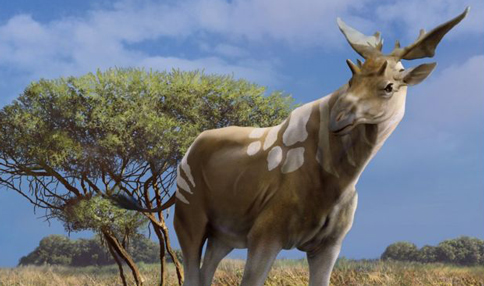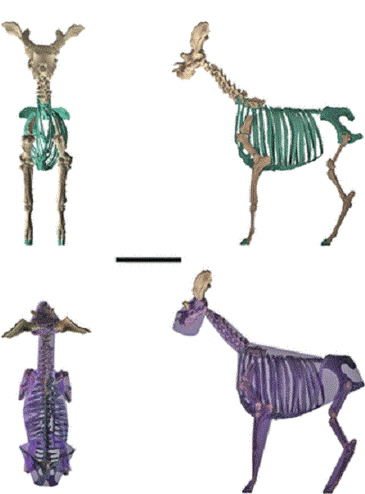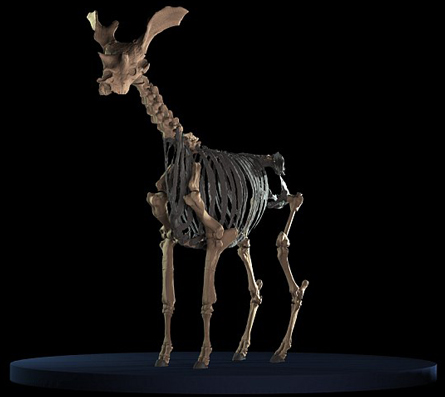Sivatherium giganteum – Not Quite So Giganteum!
A re-assessment of an ancient prehistoric mammal that once roamed the foothills of the Himalayas, has led to the palaeontological shrink ray being employed once again. The beast, an ancient giraffid named Sivatherium giganteum (pronounced See-vah-fear-ree-um jai-gant-tee-um) was once thought to be some form of missing link between elephants and giraffes, 19th century scientists thought that it was about as big as an African elephant. However, a digital reconstruction and re-examination of the fossilised bones of these herbivores has led to a new body mass estimate of around 1,250 kilogrammes (a range of 857 kg to 1,812 kg).
Sivatherium giganteum – Once Thought to be a Missing Link Between Elephants and Giraffes
Picture credit: Science Photo Library
Sivatherium giganteum
The first fossil specimen to be scientifically studied was found by Scottish geologist Hugh Falconer who accompanied the English engineer Proby Thomas Cautley on an expedition to map the terrain of the Sivalik Hills in the sub-Himalayas region of India. A scientific paper naming and describing this animal was published in a journal called the “Philosophical Magazine Series” back in 1836. Despite further fossil finds and the naming of a number of Sivatherium species (India and Africa), until now there had been no attempt at a complete skeletal reconstruction of the creature.
Calculating the Body Mass of an Extinct Mammal
The bones that make up the skeleton were digitally mapped and then the animal was reconstructed. The researchers, which included scientists from the Royal Veterinary College, were able to calculate a range of body masses for this impressive beast, although this new research (published in Biology Letters), suggests that the 19th century study did over estimate the body mass by a considerable margin.
Commenting on the work of his predecessors, Christopher Basu (co-author of the new study) stated that the 19th century team did a “beautiful job at describing it and taking measurements, although it turns out the body mass calculation was educated guesswork.”
As part of a wider investigation into the anatomy of modern giraffes, the three-dimensional computer model of S. giganteum provides a much more accurate estimate of body mass. “Sivas Beast” had particularly robust bones and the body mass estimate provided by the earlier research was based on a volumetric measure. However, assessment of the weight bearing capacity of the humerus (humeral circumference) and other measurements in this new study provides a more accurate reading.
One of the Largest Ruminants Known to Science
Although, not quite on the scale of a modern African elephant, Sivatherium giganteum is one of the largest ruminants known to science. Males may well have been slightly heavier than the average body weight given in this new research, they had very large horns and these spectacular appendages would have increased their overall body mass.
Skeletal Reconstruction of Sivatherium giganteum
Picture credit: Royal Veterinary College/Biology Letters
In the picture above the skeletal reconstruction in green (top) shows Sivatherium modelled against a modern Giraffa. The outline in purple and the bones (also in purple) provide an outline of the minimum body proportions modelled onto the skeletal frame.
To view Everything Dinosaur’s range of prehistoric mammal models: Prehistoric Mammal Models.
Commenting on the study, carried out in association with Liverpool John Moores University, PhD student Christopher Basu explained:
“As a palaeontologist, it is really important to understand the basic question – how big was this animal? This was probably the largest giraffe relative to have ever existed, which makes it the largest ruminant that’s ever existed. It’s a rare animal, it’s pushing the limits of its anatomy.”
A Short Neck and a Robust Body
With its short neck and robust body, S. giganteum may not look much like a modern giraffe, but surprisingly, this animal co-existed with modern giraffes in Africa. Fossil evidence suggests that Sivatherium may have survived into the Holocene Epoch. In addition, archaeologists have discovered a series of rock drawings dating from between 10,000 and 8,000 years ago at various locations in the Sahara region of North Africa that depict animals that resemble Sivatherium. Although, it is difficult to say beyond doubt that these images resemble Sivatherium it is an intriguing and interesting thought.
The Reconstructed Skeleton of Sivatherium giganteum
Picture credit: Royal Veterinary College/Biology Letters
To read an article about an ancient ruminant and its links to a Star Wars character: Xenokeryx and Giraffes – Something To Ruminate On.









Leave A Comment